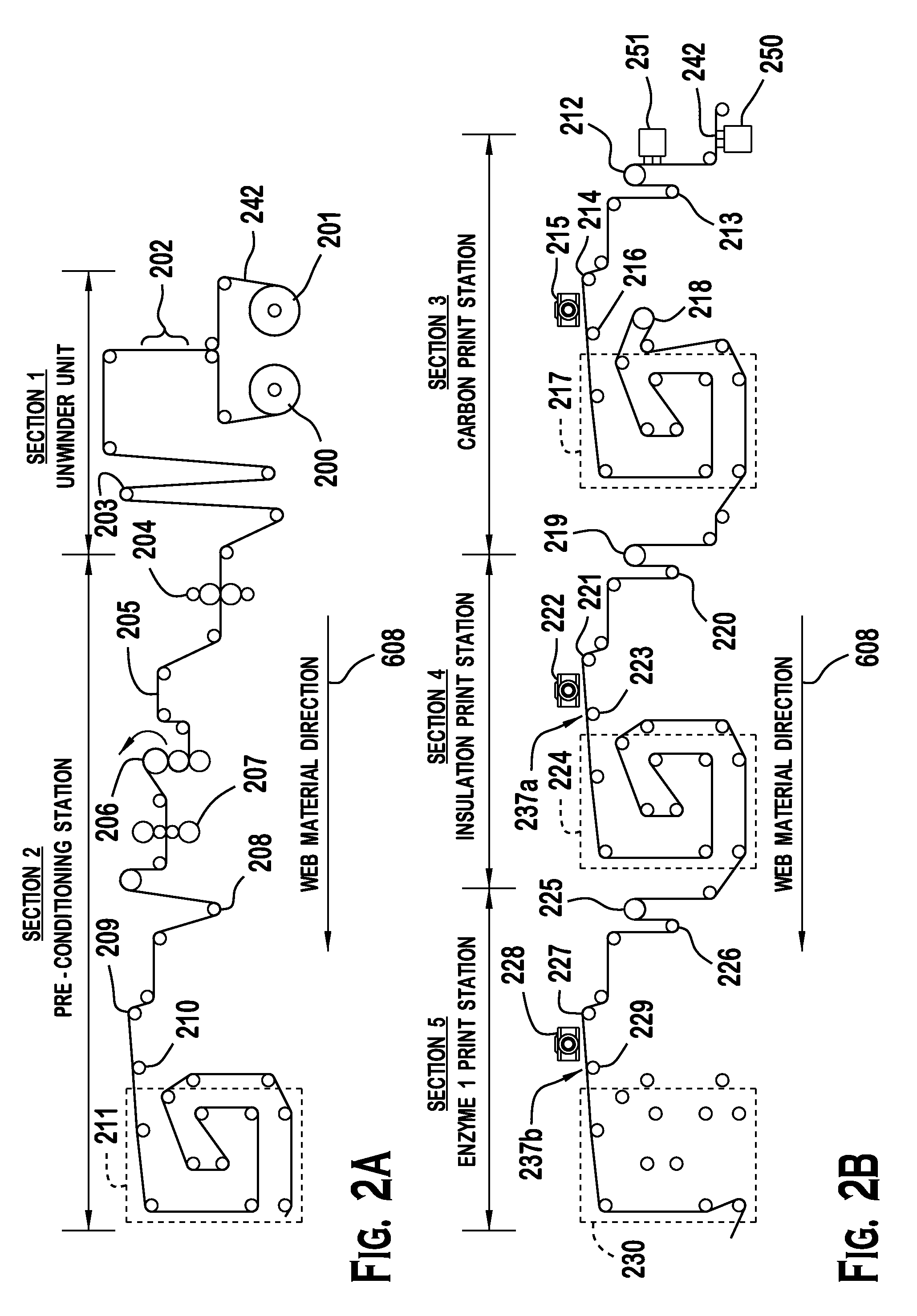Test strips, methods, and system of manufacturing test strip lots having a predetermined calibration characteristic
a technology of calibration characteristic and test strip, which is applied in the field of test strip, methods and system of manufacturing test strip lots having a predetermined calibration characteristic, can solve problems such as inaccuracy of analyte results, and achieve the effect of reducing pressur
- Summary
- Abstract
- Description
- Claims
- Application Information
AI Technical Summary
Benefits of technology
Problems solved by technology
Method used
Image
Examples
example 1
[0291]A first test strip lot was calibrated to have a batch slope of about 18 nA / mg / dL and a batch intercept of about 320 nA, as illustrated by a triangle in FIGS. 30 and 31. The first test strip lot had an electrode width X3, defined by the insulation aperture width, of about 0.7 mm and no added ferrocyanide to the reagent layer. Next, seven test strip lots were prepared where each test strip lot had a different electrode width X3. The electrode widths X3 employed were 0.56, 0.62, 0.66, 0.70 and 0.84 mm. Each of the seven test strip lots had about one gram of ferrocyanide added to the reagent ink (in a nominal 6 kg (e.g. 6.004, 6.017, 6.024, 6.027, 6.034 or 6.037 kg) batch of ink containing nominal 1.4 kg (e.g. 1.365, 1.375, 1.385 or 1.395 kg) of ferricyanide). An actual batch slope and batch intercept was determined through a calibration with blood samples having a known glucose concentration. The actual batch slope and batch intercept values for the test strip lots having a range...
example 2
[0323]However, if it were determined using Equations 6 or 7 that an electrode width other than about 700 microns was required, it would be necessary to normalize the background intercept B0 and the empirically derived constant Kint to another electrode width. The following example describes how to calculate Fadd if the electrode width was about 725 microns. Equations 10 and 11 show how to normalize B0 and Kint to account for an electrode width of about 725 microns.
B0(725)=298 nA*(725 / 700) about 309 nA Eq. 10
Kint(725)=65.5 nA / g per ink*(725 / 700)=about 67.8 nA / gram ferrocyanide Eq. 11
[0324]Using the normalized values of B0 and Kint to account for an electrode width of 725 microns, Fadd can be calculated using Equation 9A.
Fadd=Btarget-B0Kint-Fimp=487-30967.8-1.45≅1.17grams.
Thus, about 1.17 grams of ferrocyanide can be blended with the reagent ink when making test strip batches having an electrode width of about 725 microns. In an example embodiment, ferrocyanide of from 1 gram to 9 g...
example 3
[0339]The first solution can be prepared by mixing together a buffered polymer solution with silica having hydrophilic and hydrophobic groups. More specifically, approximately 675 grams Cabosil TS-610 (surface treated fumed silica having hydrophilic and hydrophobic groups) or Wacker H15 Silica can be mixed with approximately 9000 grams of buffered polymer solution. The buffered polymer solution contains a weight % of the following ingredients of approximately 0.46% DC 1500 Antifoam, approximately 0.91% PVP-VA S-630, approximately 0.83% citric acid, approximately 2.74% tri-sodium citrate, approximately 0.91% PVP-VA S-630, approximately 4.62% Natrosol 250 G, and approximately 89.52% water. The Cabosil TS-610 can be dispersed in the buffered polymer solution using a Dispermat mixer for about 16 minute mixing time at approximately 3,000 rotations per minute. Note that various embodiments described herein are not limited to mixing using a propeller blade and that other forms of mixing su...
PUM
| Property | Measurement | Unit |
|---|---|---|
| width | aaaaa | aaaaa |
| area | aaaaa | aaaaa |
| width | aaaaa | aaaaa |
Abstract
Description
Claims
Application Information
 Login to View More
Login to View More - R&D
- Intellectual Property
- Life Sciences
- Materials
- Tech Scout
- Unparalleled Data Quality
- Higher Quality Content
- 60% Fewer Hallucinations
Browse by: Latest US Patents, China's latest patents, Technical Efficacy Thesaurus, Application Domain, Technology Topic, Popular Technical Reports.
© 2025 PatSnap. All rights reserved.Legal|Privacy policy|Modern Slavery Act Transparency Statement|Sitemap|About US| Contact US: help@patsnap.com



